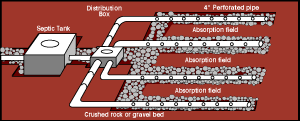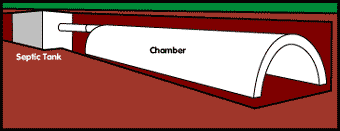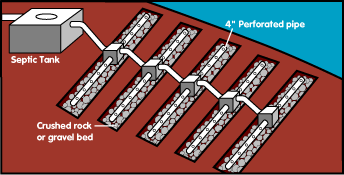

 |
|
|
|
TYPES OF SOIL ABSORPTION SYSTEMS There are many designs for the drainfield. The drainfield may be constructed as a bed (5), individual trenches for each lateral (1), a seepage pit (2), or, in the special case where there is no septic tank, a cesspool. It may have a distribution box, a drop-box system (4), or no distribution box. This is mainly a function of the local custom. Most systems have a distribution box. The drainfield may be elevated where a pump is needed to raise the water to a higher level. The water may flow into the ground by gravity or the system can be pressurized. If you have a septic system, you should know the characteristics of your system. You should know where the drainfield is located and where the distribution box is. If you do not have a distribution box, you should consider having a riser installed between the septic tank and the drainfield. This will allow for easier inspection of the system and simplify treatment of the drainfield for possible restoration if the drainfield starts to fail and for preventative maintenance. HOW IS THE DRAINFIELD CONSTRUCTED
The drainfield consists of perforated pipe which allows the water to pass into the ground. This pipe is generally PVC, but in older systems it may consist of more fragile pipe. Generally, it is constructed by excavating soil down to a depth where the soil perks (absorbs water) at a rate approved by local authorities. If this is a depth greater than about 25" - 30", then select fill should be added to bring the level back up to about 30 inches. Six to eight inches of stone are added and the drainfield pipe is laid on this. Stone is then added to bring the level to about four inches above the pipe. A layer of geotextile fabric is placed on top of the stone to keep soil out of the field and then soil added up to ground level. |





